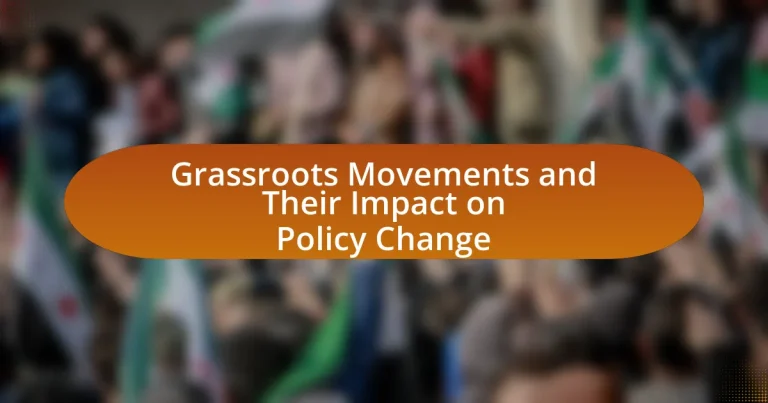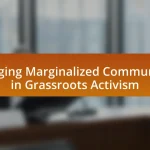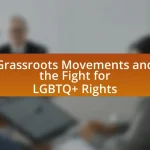Grassroots movements are organized efforts by ordinary individuals aimed at achieving social or political change within their communities. This article explores the origins, characteristics, and key players involved in grassroots movements, highlighting how they arise in response to social injustices and mobilize community support. It examines the strategies employed by these movements to influence policy change, the role of social media in amplifying their impact, and the challenges they face, including political opposition and resource limitations. Additionally, the article discusses best practices for enhancing the effectiveness of grassroots initiatives and the importance of continuous education in sustaining their efforts.
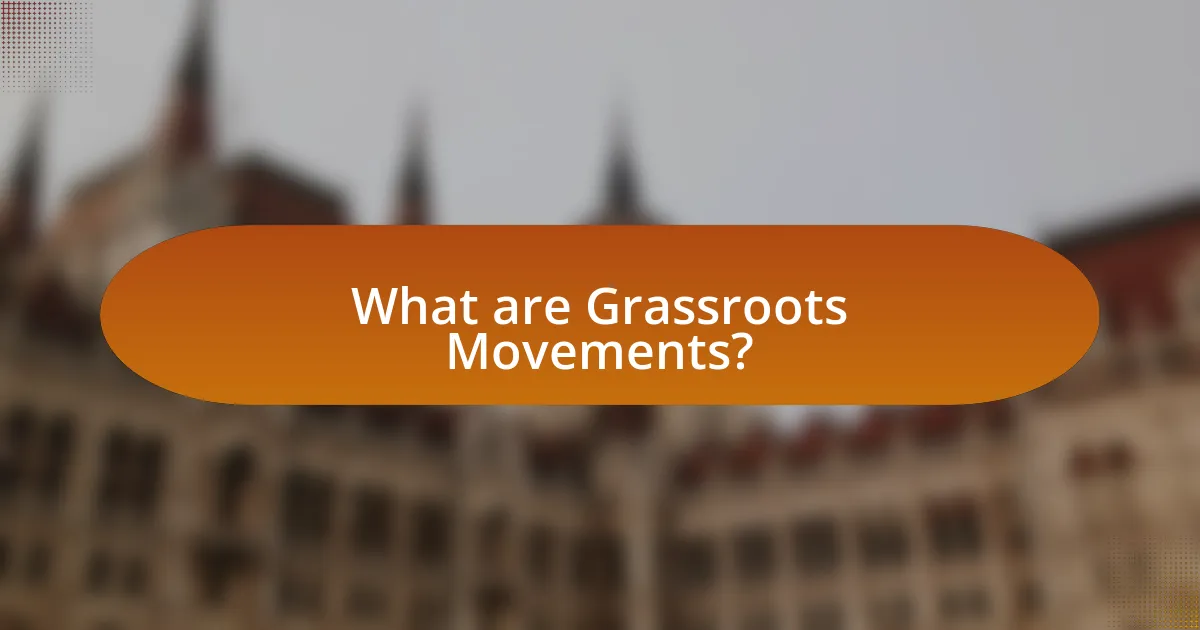
What are Grassroots Movements?
Grassroots movements are organized efforts by ordinary people to effect social or political change at the community level. These movements typically arise from the collective actions of individuals who share common interests or grievances, aiming to influence public policy or societal norms. For example, the Civil Rights Movement in the United States during the 1950s and 1960s was a grassroots effort that sought to end racial segregation and discrimination, leading to significant legislative changes such as the Civil Rights Act of 1964. This illustrates how grassroots movements can mobilize community support and drive policy change through collective action and advocacy.
How do Grassroots Movements originate?
Grassroots movements originate from collective action by individuals at the community level who seek to address specific social, political, or environmental issues. These movements typically emerge in response to perceived injustices or unmet needs, often fueled by shared experiences and a desire for change among community members. Historical examples include the Civil Rights Movement in the United States, which arose from widespread discrimination and a collective demand for equal rights, demonstrating how grassroots efforts can mobilize communities to advocate for policy changes.
What social conditions lead to the formation of Grassroots Movements?
Grassroots movements typically form in response to social conditions such as economic inequality, political disenfranchisement, and social injustice. These conditions create a sense of urgency and collective identity among individuals who feel marginalized or oppressed. For instance, the Civil Rights Movement in the United States emerged from systemic racism and economic disparities faced by African Americans, leading to organized efforts for equality and justice. Additionally, the rise of social media has facilitated the mobilization of grassroots movements by providing platforms for communication and organization, as seen in movements like Black Lives Matter, which gained momentum in response to police violence and racial discrimination. These social conditions not only catalyze grassroots movements but also shape their goals and strategies for effecting change.
Who are the key players in Grassroots Movements?
Key players in grassroots movements include community organizers, activists, volunteers, and local leaders. Community organizers mobilize individuals around specific issues, while activists advocate for change through various forms of protest and awareness campaigns. Volunteers contribute their time and resources to support the movement’s goals, and local leaders often emerge as spokespersons or representatives, helping to amplify the movement’s message. These players collectively drive grassroots initiatives, influencing policy change by raising awareness, building coalitions, and engaging with policymakers.
What are the characteristics of Grassroots Movements?
Grassroots movements are characterized by their community-driven nature, emphasizing local participation and activism. These movements typically arise from the collective efforts of individuals at the local level, seeking to address social, political, or environmental issues. They often rely on volunteer efforts, grassroots organizing, and direct action to mobilize support and influence change. Evidence of their effectiveness can be seen in historical examples such as the Civil Rights Movement in the United States, which was largely driven by grassroots activism and community engagement, leading to significant policy changes like the Civil Rights Act of 1964.
How do Grassroots Movements differ from traditional movements?
Grassroots movements differ from traditional movements primarily in their structure and approach to mobilization. Grassroots movements are typically decentralized, relying on local communities and individuals to drive change from the bottom up, whereas traditional movements often have a hierarchical structure with established leadership and formal organizations. For example, the Civil Rights Movement in the United States had prominent leaders like Martin Luther King Jr., while grassroots movements like the Black Lives Matter movement emphasize collective action and community involvement without a singular leader. This decentralized nature allows grassroots movements to be more adaptable and responsive to local issues, fostering a sense of ownership among participants.
What strategies do Grassroots Movements employ?
Grassroots movements employ strategies such as community organizing, advocacy, coalition building, and direct action to effect change. Community organizing involves mobilizing local individuals to address issues collectively, fostering a sense of ownership and empowerment. Advocacy focuses on influencing policymakers through lobbying, public campaigns, and raising awareness about specific issues. Coalition building brings together diverse groups to strengthen their collective voice and increase impact. Direct action includes protests, sit-ins, and other forms of civil disobedience to draw attention to causes and demand immediate change. These strategies have been effective in various historical contexts, such as the Civil Rights Movement, which utilized these methods to challenge systemic racism and achieve significant legislative reforms.
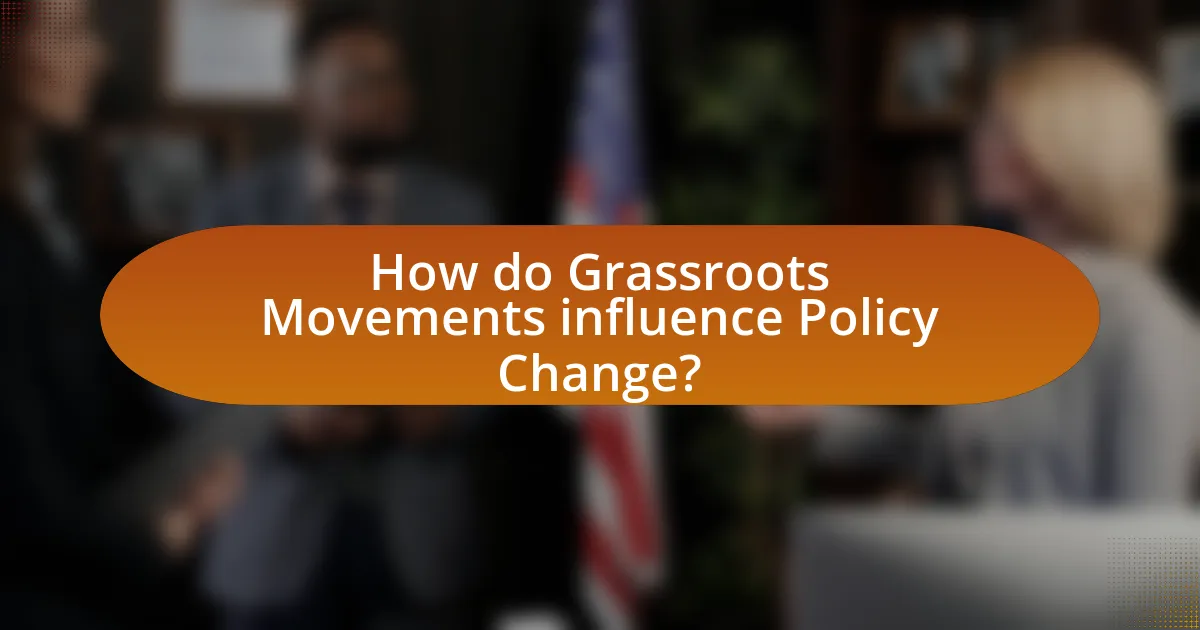
How do Grassroots Movements influence Policy Change?
Grassroots movements influence policy change by mobilizing community members to advocate for specific issues, thereby creating pressure on policymakers. These movements often utilize strategies such as organizing protests, engaging in lobbying efforts, and leveraging social media to raise awareness and build public support. For instance, the Civil Rights Movement in the United States successfully led to significant legislative changes, including the Civil Rights Act of 1964, by organizing mass demonstrations and fostering widespread public engagement. This historical example illustrates how grassroots activism can effectively shift public opinion and compel government action, demonstrating the tangible impact these movements can have on policy outcomes.
What mechanisms do Grassroots Movements use to impact policy?
Grassroots movements impact policy through mechanisms such as mobilization, advocacy, coalition-building, and public awareness campaigns. Mobilization involves organizing community members to participate in protests, rallies, and other forms of direct action, which can draw attention to specific issues and pressure policymakers. Advocacy efforts focus on lobbying government officials and influencing legislative processes, often utilizing research and data to support their positions. Coalition-building allows grassroots movements to unite with other organizations, amplifying their voice and resources, which can lead to more significant political influence. Public awareness campaigns leverage media and social platforms to educate the public and garner support, creating a broader base for policy change. For example, the Civil Rights Movement utilized these mechanisms effectively, leading to landmark legislation such as the Civil Rights Act of 1964.
How do Grassroots Movements mobilize public support?
Grassroots movements mobilize public support by leveraging community engagement, social media, and local networks to raise awareness and drive collective action. These movements often focus on specific issues that resonate with the public, such as environmental concerns or social justice, creating a sense of urgency and shared purpose. For instance, the Black Lives Matter movement utilized social media platforms to amplify its message, resulting in widespread protests and increased public discourse on racial inequality. Research indicates that grassroots campaigns can significantly influence public opinion and policy outcomes, as seen in the successful push for climate action in various regions, where local advocacy led to legislative changes.
What role does social media play in Grassroots Movements’ influence?
Social media significantly amplifies the influence of grassroots movements by facilitating rapid communication, mobilization, and awareness. Platforms like Twitter and Facebook allow grassroots organizations to disseminate information quickly, engage supporters, and organize events, which can lead to increased participation and visibility. For instance, the Black Lives Matter movement effectively utilized social media to raise awareness about racial injustice, resulting in widespread protests and policy discussions across the globe. Research indicates that social media can enhance the reach of grassroots campaigns, with studies showing that movements leveraging these platforms often achieve greater public engagement and media coverage compared to those that do not.
Why are Grassroots Movements effective in driving policy change?
Grassroots movements are effective in driving policy change because they mobilize community members to advocate for specific issues, creating a powerful collective voice. This collective action often leads to increased public awareness and pressure on policymakers to respond to the demands of constituents. For instance, the Civil Rights Movement in the United States successfully influenced legislation such as the Civil Rights Act of 1964 through organized protests and grassroots advocacy, demonstrating how sustained community engagement can lead to significant policy reforms.
What evidence exists to support the effectiveness of Grassroots Movements?
Grassroots movements have demonstrated effectiveness in influencing policy change through various documented instances. For example, the Civil Rights Movement in the United States, particularly the Montgomery Bus Boycott of 1955-1956, led to significant legal changes, including the Supreme Court ruling that segregation on public buses was unconstitutional. Additionally, the environmental movement, exemplified by the 2014 People’s Climate March, mobilized over 400,000 participants, raising awareness and leading to international agreements like the Paris Accord in 2015. Research by the Stanford Social Innovation Review indicates that grassroots campaigns can effectively shift public opinion and policy, as seen in the successful push for marriage equality in the U.S., which was largely driven by grassroots advocacy. These examples provide concrete evidence of grassroots movements’ capacity to effectuate meaningful policy changes.
How do Grassroots Movements create a sense of urgency for policy change?
Grassroots movements create a sense of urgency for policy change by mobilizing community members around pressing social issues, thereby amplifying public awareness and pressure on decision-makers. These movements often utilize social media, public demonstrations, and targeted campaigns to highlight injustices and demand immediate action, effectively transforming local concerns into national conversations. For instance, the Black Lives Matter movement has successfully raised awareness about systemic racism and police brutality, leading to policy discussions and reforms in various jurisdictions. This urgency is further reinforced by the emotional narratives shared by individuals affected by the issues, which resonate with broader audiences and compel policymakers to respond swiftly.
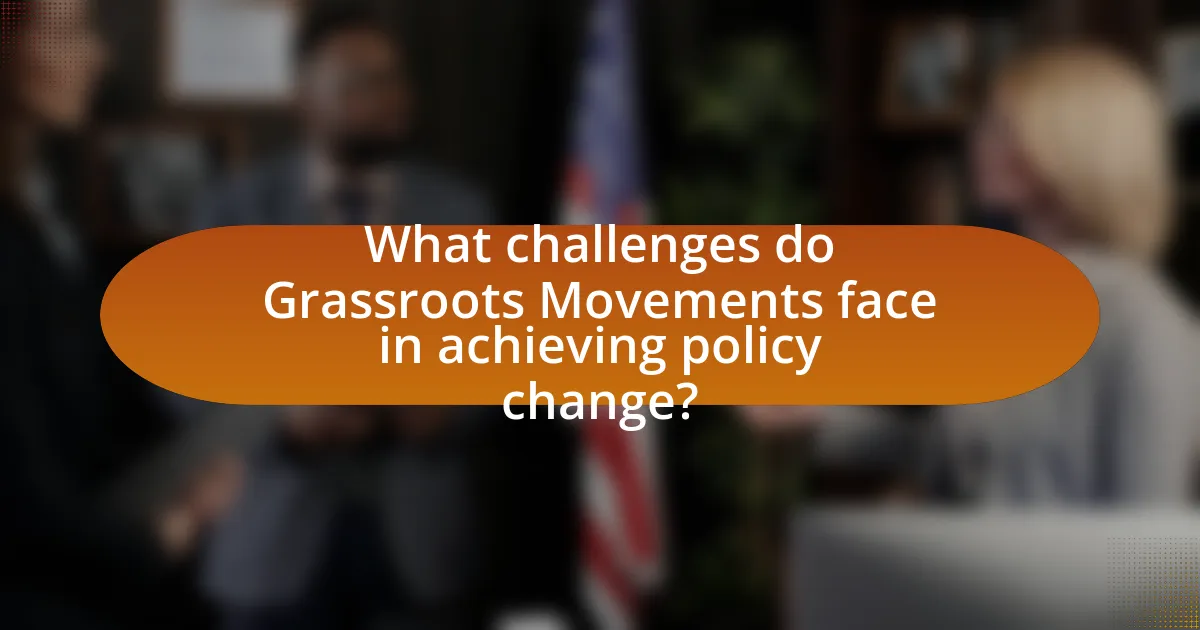
What challenges do Grassroots Movements face in achieving policy change?
Grassroots movements face significant challenges in achieving policy change, primarily due to limited resources, political resistance, and lack of access to decision-makers. Limited financial and human resources hinder their ability to mobilize effectively and sustain campaigns. Political resistance often arises from established interests that oppose the changes advocated by these movements, leading to pushback from lawmakers and stakeholders. Additionally, grassroots movements frequently struggle to gain direct access to policymakers, which is crucial for influencing legislative processes. For instance, a study by the National Democratic Institute found that grassroots organizations often lack the lobbying power and connections that larger, well-funded entities possess, making it difficult for them to effectuate meaningful policy changes.
What obstacles hinder the success of Grassroots Movements?
Grassroots movements face several obstacles that hinder their success, including lack of funding, organizational challenges, and opposition from established power structures. Limited financial resources restrict their ability to mobilize effectively and sustain campaigns, as evidenced by studies showing that movements with greater funding often achieve more significant impact. Organizational challenges, such as coordination among diverse groups and maintaining volunteer engagement, can lead to inefficiencies and fragmentation. Additionally, established power structures often resist grassroots initiatives, employing tactics such as lobbying or legal challenges to undermine their efforts, which has been documented in various case studies of social movements.
How do political opposition and institutional barriers affect Grassroots Movements?
Political opposition and institutional barriers significantly hinder grassroots movements by limiting their access to resources, visibility, and political influence. Grassroots movements often rely on community support and engagement to drive change; however, when faced with organized political opposition, such as government pushback or counter-movements, their efforts can be stifled. For instance, in the case of the civil rights movement in the United States, activists encountered severe opposition from local and state governments, which employed legal and extralegal measures to suppress protests and limit organizational activities. Additionally, institutional barriers, such as restrictive laws on assembly or funding limitations, can further isolate grassroots initiatives, making it difficult for them to mobilize effectively. These dynamics illustrate how political opposition and institutional barriers can create an environment that is hostile to grassroots efforts, ultimately affecting their ability to influence policy change.
What internal challenges do Grassroots Movements encounter?
Grassroots movements encounter several internal challenges, including lack of resources, leadership conflicts, and difficulties in maintaining cohesion among diverse members. These challenges can hinder their effectiveness and sustainability. For instance, limited funding often restricts outreach and operational capabilities, while leadership disputes can create divisions that weaken the movement’s focus and unity. Additionally, the diversity of perspectives within grassroots movements can lead to disagreements on strategies and goals, complicating decision-making processes. These internal dynamics are critical as they directly affect the movement’s ability to influence policy change effectively.
How can Grassroots Movements overcome these challenges?
Grassroots movements can overcome challenges by building strong community networks and leveraging digital platforms for mobilization. These networks foster collaboration and resource sharing, which enhances resilience against opposition. For instance, the Black Lives Matter movement effectively utilized social media to organize protests and raise awareness, demonstrating the power of digital engagement in amplifying grassroots efforts. Additionally, grassroots movements can engage in strategic partnerships with established organizations to gain credibility and access to resources, as seen in various environmental campaigns that have successfully aligned with larger NGOs to influence policy change.
What strategies can enhance the effectiveness of Grassroots Movements?
To enhance the effectiveness of grassroots movements, building strong community networks is essential. These networks facilitate collaboration, resource sharing, and collective action, which are critical for mobilizing support and amplifying voices. Research indicates that grassroots movements with robust local connections are more successful in achieving policy change, as seen in the success of the Civil Rights Movement, where community organizing played a pivotal role in mobilizing public support and influencing legislation. Additionally, utilizing social media platforms effectively can broaden outreach and engagement, allowing movements to connect with a larger audience and raise awareness about their causes. Studies show that movements leveraging digital tools can increase participation and visibility, leading to greater impact.
How can collaboration with other organizations benefit Grassroots Movements?
Collaboration with other organizations can significantly enhance grassroots movements by providing access to additional resources, expertise, and networks. When grassroots movements partner with established organizations, they can leverage funding, technical support, and advocacy experience, which can amplify their reach and effectiveness. For instance, a study by the National Council of Nonprofits highlights that collaborations can lead to increased visibility and credibility, enabling grassroots movements to influence policy changes more effectively. This synergy often results in a stronger collective voice, which is crucial for driving social change and achieving legislative goals.
What best practices can Grassroots Movements adopt for successful policy change?
Grassroots movements can adopt several best practices for successful policy change, including building a strong coalition, engaging in strategic communication, and leveraging data to support their initiatives. Building a strong coalition involves uniting diverse stakeholders who share common goals, which enhances credibility and amplifies voices. Engaging in strategic communication ensures that messages resonate with target audiences, utilizing social media and traditional media effectively to raise awareness and mobilize support. Leveraging data involves using research and statistics to substantiate claims, making arguments more compelling; for instance, studies show that movements that present clear, data-driven evidence are more likely to influence policymakers. These practices have been observed in successful movements, such as the Civil Rights Movement, which effectively combined coalition-building, strategic messaging, and data to achieve significant legislative changes.
How can Grassroots Movements effectively engage their communities?
Grassroots movements can effectively engage their communities by fostering inclusive participation and utilizing local networks to amplify their message. By organizing community meetings, workshops, and events, these movements create platforms for dialogue and collaboration, ensuring that diverse voices are heard. Research indicates that grassroots organizations that prioritize community involvement see higher levels of engagement and support; for instance, the National Community Reinvestment Coalition found that community-led initiatives lead to more sustainable outcomes in policy advocacy. Additionally, leveraging social media and digital tools allows grassroots movements to reach wider audiences, mobilizing support quickly and efficiently.
What role does continuous education play in sustaining Grassroots Movements?
Continuous education is essential for sustaining grassroots movements as it empowers participants with knowledge, skills, and strategies necessary for effective advocacy and mobilization. By providing ongoing training and resources, grassroots organizations can enhance their members’ understanding of social issues, legal frameworks, and community organizing techniques. For instance, studies have shown that movements with well-informed members are more likely to achieve their goals; the Civil Rights Movement utilized educational workshops to equip activists with the tools needed for nonviolent protest and legal challenges. This continuous learning fosters resilience, adaptability, and a deeper commitment to the movement’s objectives, ultimately leading to more significant policy changes and community impact.
